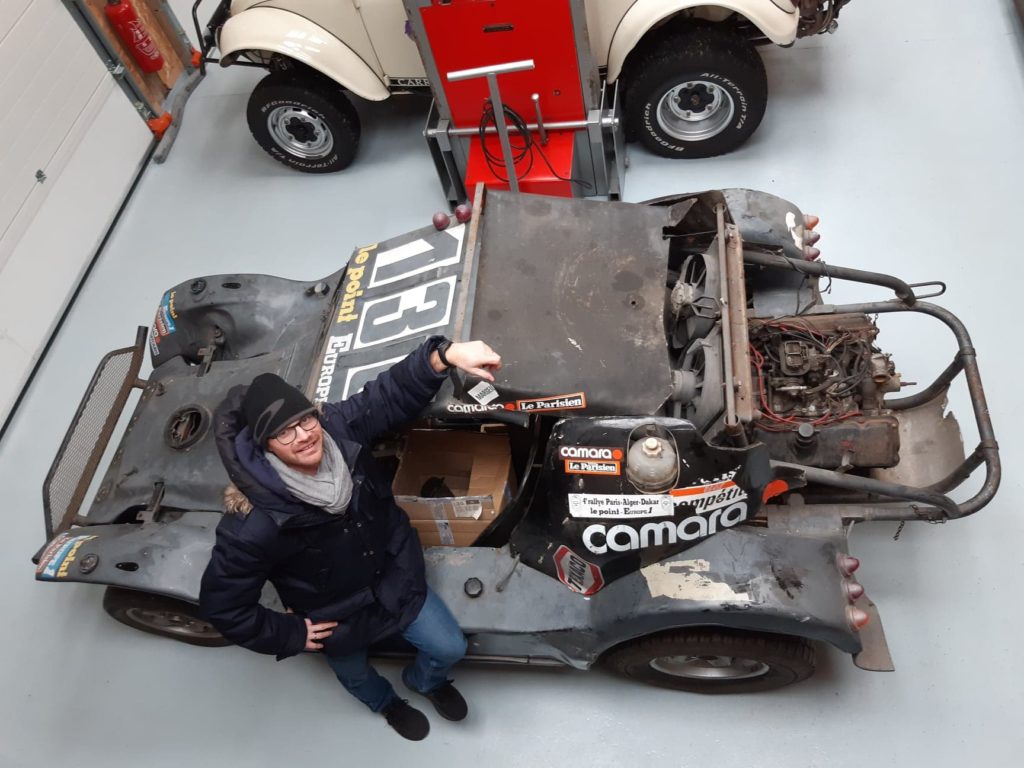Buggy Strakit (EN)
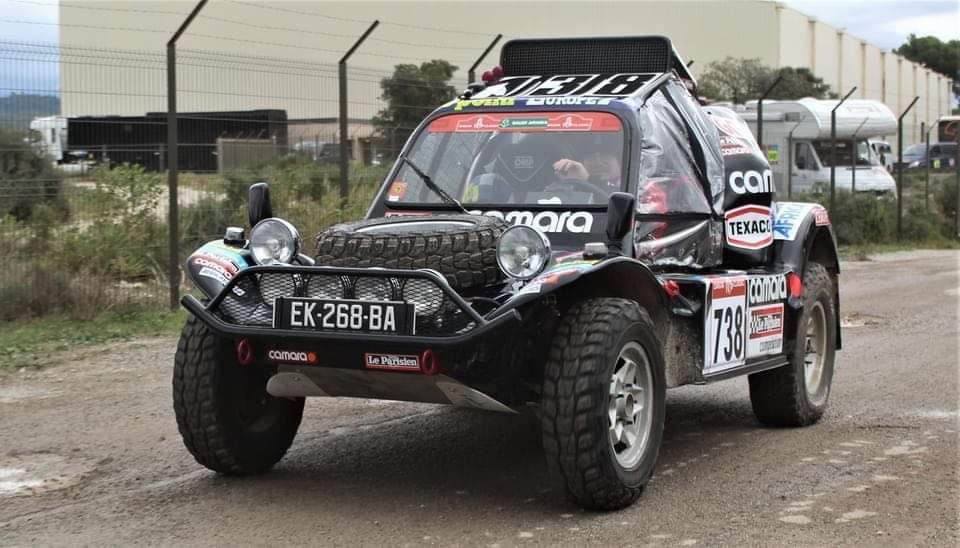
Brand : Base buggy strakit
Model : proto made by Guy Levy
Engine : 2, 8L
Max speed : 200kmh
Power : 160 Ch
Weight : 1300kg
Dimensions : ? L : m x W : 1, m x H : 1. m
Preparer : BARLERIN And Co
Assistance : Team Logistic Rallye
Category : H0 Auto Classic before 86
History
Told by Mr Dakardantan, Jeff, who allowed us to use his text and images. (Facebook : DAKARDANTAN.COM)
The Strakit n°138 of the 1982 Paris-Dakar…The buggy that comes back to the rally 40 years later…(1/3)On December 31, 2022, for the third edition of the Dakar Classic, a strange little buggy will take part in the rally…for a second attempt!
Entirely restored by Frédéric Barlerin and his commando team, this vehicle participated in the Dakar for the first time just 40 years ago, during the 1982 edition.
Built and driven by Guy Levy, associated with his excellent friend Jean-Jacques Maréchal, it was indeed one of the 238 cars entered that year!
A look back at this adventure that began four decades ago and continues to generate dreams even today!
The story begins long before this 1982 Dakar, in fact. A long time before, at the time when Guy Levy, fresh out of his mechanical studies, was first hired at Simca, then Citroën before working at Autobleu in Levallois, a car tuner specialising in the modification and construction of camshafts and cylinder heads for competition (also a Weber specialist for tuning). Shortly afterwards he worked again at Darena and then Beauzon, specialists in engine preparation and rebuilding.
As you can see, Guy is very passionate about motor racing. And he puts his know-how at the service of his own customers when he opens his garage in Gennevilliers with a partner, as well as a personal service station in Sarcelles, in the Val d’Oise.
Among his customers and friends (we will see that this value of friendship comes up a lot in this adventure), there is a certain Thierry Sabine, who comes to have his rally cars maintained and prepared at the beginning of the 70s, such as the Alpine 1300S with which he took part in the Touquet rally or his Porsche 911 2.2l, which enabled him to win the « Tour de France National » or the Picardie rally. At the same time, Guy also tried his hand at racing, but more on the circuit with an Alfa or also a Porsche 911.a few years later, Thierry could no longer have his cars prepared at home. Friendship is always present, and when the Paris-Dakar is created, Guy has only one desire,… to participate.
Especially since during his military service, he already had the opportunity to discover Tamanrasset, In Salah, El Goléa and to fall in love with the desert. He even promised himself to return one day, one way or another.
And then life took its course, work, the garage and service station with staff and his wife, the growing family, … the moment has not yet come.
It was without counting on other friends (I warned you!) who used to come to the station, in the person of Gilles Ouaki and René Lézy. Without them the dream would have remained a dream.
At the end of the winter of 1981, they discussed together at the station and worked out a project. Thanks to the financing of Le Parisien (Gilles) and Camara (René) for a little more than 50% of the project, with a contribution from Guy, why not take on a crew and assistance for the next Paris-Dakar 1982? Agreed, but with two conditions… Guy wants to have the choice of vehicle and he already has an idea. And above all, he wants to go with his very close friend, Jean-Jacques Maréchal, as a team-mate!
Jean-Jacques is a bodyguard and looks after various personalities, including Michel Barroin, a personal friend of Jacques Chirac and then president of the GMF. He has almost no experience in either mechanics or driving, but apart from being a dear friend, he is a man you can count on in all circumstances, capable of managing exceptional situations, keeping calm and pragmatic, in short, everything you need when you go on a Dakar adventure!
As far as the vehicle is concerned, as we said, Guy already has his idea, which is based on his experience in the field when he did his military service in Africa. He knows that a powerful but above all very light vehicle can get out of various situations much better than a vehicle that is too heavy!
As a result, Guy wanted to work on a buggy and above all to build it … in his own way!
So he turned to one of the specialists in this type of vehicle at the time, Strakit.
This company, founded in the early 1970s by Michel Cattoire, a young French industrialist specialising in polyester, offered complete buggies, chassis or transformation kits on different bases, several of which were very successful in off-road rallies (French champion in 1975, for example!)
In association with Strakit, Guy will acquire a buggy structure, in fact a cockpit and a body. The rest, i.e. the running gear, suspension, engine and gearbox, he takes care of!
His first choice was the front axle, which came from a VW Beetle, lighter than those of the Combi. The rear axle will come from a Porsche 911 with aluminium arms. The suspensions will also be prepared with the help of De Carbon and Koni, who will offer dampers with different settings and valves than the standard ones, and specifically dedicated to competition. A De Carbon/Koni unit will be fitted at the rear, while a single De Carbon unit will dampen each front wheel. Several tests (around 1000km) will be carried out before the Dakar to fine-tune the settings of the different dampers.
This first part of the car’s assembly will be done at Guy’s home, and as soon as the buggy is running, he will go to the garage in Sarcelles to continue the preparation. Aware of his project, he informed him that he had just recovered an Alpine A310 that had been in an accident, with barely 15,000 km on the odometer and whose mechanics were intact!
So it’s the whole engine box of this Alpine A310 that will be in the buggy! This is not a small task, because it will be necessary to reverse the bevel gear, to couple the gearbox and to rebuild the whole thing!
For more security, Guy will decide to use a Renault standard exchange gearbox and will buy this part directly from Renault Compétition.Concerning the motorisation, Guy will once again use his know-how. He chose to fit « Ferry » intake manifolds, two Weber triple-body carburettors, an original Porsche air filter plus a specific one, two Devil exhaust manifolds as well as an exhaust line with a « silencer » from the same brand (the exhaust was almost free in fact!).
As for autonomy, the fuel tanks are distributed on each side of the buggy with two specific plastic tanks of 60 litres each plus a filter at the tank outlet, coupled with two Bosch fuel pumps (one is a backup) allowing a balanced fuel management between each tank. In addition, a filtration system allows poor quality fuel to be cleaned before it reaches the engine! (plus 6 filters for assistance).
In the end, when Guy tests the buggy, the engine delivers between 170 and 175 hp, the maximum operating range being around 6000 rpm. It pushes hard!
As for the wheels, Guy decides to use superb forged Fuchs rims (much stronger), 6 inches at the rear and 5 at the front. They will be fitted with specific American tyres at the rear (bought from Pierre Fougerouse) and Kleber tyres at the front (Kleber will provide them with spare tyres that were fitted to Audi Quattros at the time!)
The Strakit n°138 of the 1982 Paris-Dakar…The buggy which returns to the rally 40 years later…(2/3)
In December, thanks to hard work in the evenings and weekends, the buggy is almost finished (about 1000km of testing). Guy and Jean-Jacques are going to do a promotional tour in several Camara shops and at the head office of the Parisien Libéré. They will also take the opportunity to present their assistance, namely a Toyota BJ bought by Guy from Halt-up (and entirely prepared by the brothers Dominique and Pascal Vigneron), entrusted to Tony Georget, Michel Lortie (a bodybuilder by trade who will be very welcome in the preparation of the buggy!) and Jean Boulard. In charge of parts, he will have to ensure his mission of assistance in case of need.
So it is a complete team that presents itself on the Place de la Concorde, on January 1st 1982, in their black and orange livery of the most beautiful effect!
The buggy aims for a place in the first 30 and is registered in the two-wheel drive category, but that year, there are many vehicles claiming a possible victory in this category (about twenty vehicles including ten other buggies).
As for the Toyota, with its number 338, it was also one of the almost 240 cars hoping to reach the Dakar.
On the programme of this 82 edition, 3 weeks of racing and more than 10,000 km through France, Algeria, Mali and Senegal! You can imagine how tough and demanding the selection will be!
Moreover, this selection will be very quickly terribly severe with Guy and Jean-Jacques… Too quickly even because hardly 8 km after the gate of Orleans, while the buggy tries to join the first timed special stage in Olivet, it is the catastrophe… The n°138 parks on the side and stops with enormous problems of gearbox. Indeed, since the start, Guy feels that something is wrong during the gear changes and suddenly, there is no more second gear…
Our two friends get out of the buggy and notice that a nut that is supposed to hold all the gearing at the end of the gearbox has disappeared! Not only is it gone, but the nut has also dug and perforated the oil pan!
By the way, by looking around the buggy, Jean-Jacques will find this famous nut at about twenty meters. By looking at it more closely, Guy will understand what happened… At Renault, the nut was indeed tightened (the marked sides prove it) but normally, this nut should have been crushed and braked at the factory so that it would never loosen. And obviously, this was not done! So, after a while, with the vibrations, it came loose! It broke through the 5th gear housing and also lost the second gear !
Max Meynier, passing the buggy, stops and worries about what could be the first retirement of the rally ! An appeal is launched on the airwaves to try and find a casing and seals to get to Sète, and a new gearbox to replace this one!
The magic of the Dakars worked and a Renault dealer in Sète offered to sell them a second-hand R30 gearbox to replace it!
In the meantime, it was up to them to drive down through France and participate in the two prologues. Unfortunately, the buggy, with the huge delay accumulated, is already out of the race but Thierry Sabine confirms that they can continue to participate in the event and that they will be included in this specific « Out of Time » classification!
Guy and Jean-Jacques replace the sliding nut and the crankcase as best they can. They succeeded in reaching Sète by taking part as best they could in the two timed special stages at Olivet and Les Garrigues.
Indeed, without a second gear and thus the impossibility to downshift, the buggy will very often arrive on the obstacles a little too fast, making it jump like a goat with as a consequence a very important solicitation of the front dampers. We will see that this will have great consequences for the future. But Guy finished 50th in the Garrigues, a sign that the car is working very well!
The Strakit n°138 of the 1982 Paris-Dakar…The buggy that comes back to the rally 40 years later…(3/3)
As soon as the second prologue is over, our two friends meet this famous dealer in Sète and see this providential R30. An agreement is made, the car is bought and the gearbox recovered.
Just in time to embark on the famous Tipasa and cross the Mediterranean, towards Algiers the White.
This trip will not be easy for our crew since it will be entirely devoted to transform this R30 gearbox in order to couple it to the buggy engine. And it is not an easy task because it is necessary to carry out many transformations of which to reverse the bevel gear so that it is in the good direction… and especially to adjust it! This will take them the whole trip, at the bottom of the boat’s hold!
But on the 4th of January, when the buggy arrived in Africa, after a few hundred meters, the gearbox exchange can finally take place! And the R30’s gearbox has its famous tightened and braked nut!
However, during the long journey of almost 500 km to Ouled-Jellad, Guy and Jean-Jacques noticed that fate was getting the better of them.
Indeed, during a manoeuvre, they realise that the reverse gear does not hold and systematically jumps. After examination, they find that the locking ball is not present. There is no doubt that it must have fallen out during the modifications at the bottom of the Tipasa, and there is a good chance that it is still somewhere in the hold of the Ferry!
The first real Algerian special stages will take place the next day during the Ouled Djellal-Hassi Messaoud stage. Two short timed stages that will reassure the buggy’s crew with good times and above all an engine that works really well. The crew preserves the buggy which has already suffered, of course with its recalcitrant gearbox but also with its suspensions strongly damaged during the two prologues! But they managed to overtake more than 60 competitors during the day!
What a pity to be out of the ranking, because the choice of a light and powerful buggy really pays off! During the 3 days that follow, the buggy is doing well, runs very well and our two companions finally take their marks. There is a problem with the reverse gear, but in the end, it is rarely used!
The biggest problem is the suspension of the little car. They show worrying signs of fragility and the brittle terrain of Algeria doesn’t help, which is what will really cause the abandonment of our little buggy n°138.
The day before the rest day, before arriving in Gao, the front axle actually succumbs, after an impact a little more violent than the others. The front left shock absorber is completely destroyed, the blade pack is blocked, and the wheel touches the bodywork! Impossible to continue and of course, no spare part in the car!
To make matters worse, the Toyota assistance team that had the spare parts does not pass by the main track and will never see the buggy stopped on the track!
Guy and Jean-Jacques, also known as Jacky, start waiting for the assistance for many minutes, then hours! When the broom truck passes, they are sure that the Toyota will arrive and they absolutely do not want to leave their little buggy! Outside the race, far behind the rally caravan, a new adventure begins! For two days, with the meagre provisions they had at their disposal (20 litres of water and a few cans), they went up the track, driving extremely slowly in order to preserve the front end. They will never exceed 10km/h!
Strangely enough, Guy and Jean-Jacques never panicked, never felt any fear or anxiety during this time, on the contrary, finding the desert absolutely soothing!
After two days, they will finally meet a native truck which goes up to Tamanrasset. The buggy is loaded in the back of the truck and the crew climbs into the cabin. It will take them three more days to reach Tam, fit but exhausted (they have lost 12 kg each!), and especially with the buggy saved!
After a well deserved rest (1 night), the crew will hire a real transporter to bring everyone (crew and car) back to Algiers where they will take the boat to Marseille, then the train to the Gare de Lyon.
This buggy will remain stored for years at Guy Levy’s house who hopes one day to drive it again, accompanied by his son. Life decided otherwise, as his son was attracted to motorbikes and then to go-karting!
For a long time, the car was kept in the same condition as when he returned from the rally, but it was eventually sold as is, passed through various hands, and even appeared for sale on « Le Bon Coin » before arriving at the home of Frédéric Barlerin, who bought it in 2021, without the PRV or the famous box.
A huge restoration project has been underway for several months now to prepare it to once again take on the tracks of the 2023 Dakar Classic, 40 years after its first participation in the event! We promise we’ll tell you more about it and we’ll follow it closely! The choice made by Guy and Jean-Jacques in 1982 was the right one!
So the dream continues, but that’s another story…
Thank you Karol and Guy Levy, Jean-noel Marechal, and Frédéric Barlerin for their precious help in writing this article!
